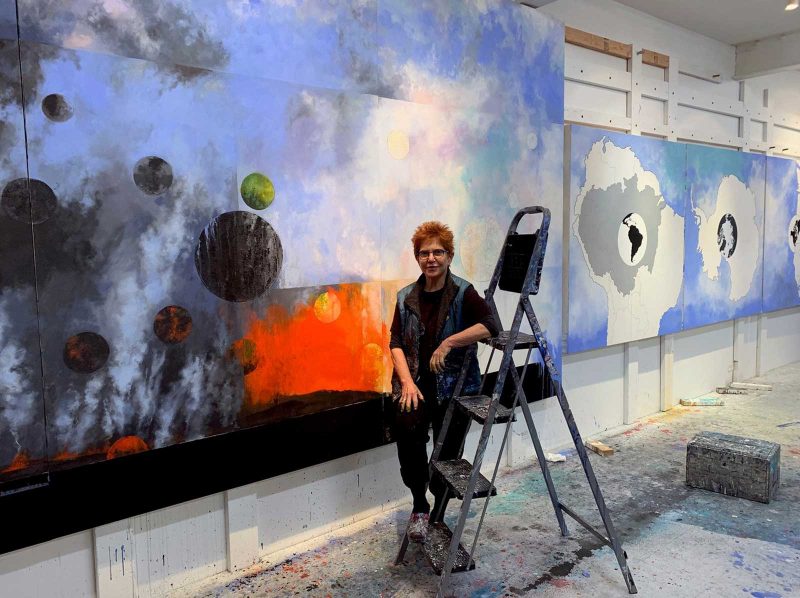
Diane Burko talks about flying with James Turrell, becoming a climate activist, and current work
By Susan IsaacsMarch 12, 2021 on Artblog
Artblog contributor Susan Isaacs connects with climate art activist Diane Burko over their shared admiration for artists like Augustus Vincent Tack, their interest in climate-focused art, and Diane's upcoming lecture at Towson University (where Susan is a professor and curator).
Diane Burko, known for her activist paintings and programs dealing with environmental issues, spoke with Susan Isaacs recently via Zoom. Burko has an upcoming live Zoom lecture at Towson University that is free and open to the public on March 25, 2021 at 6:30 p.m. and an upcoming exhibition: Seeing Climate Change: Diane Burko, 2002-2021 at the American University Museum at the Katzen Center, Washington D.C. August 28—December 12, 2021. Register for the Towson lecture.
Susan Isaacs: Hi Diane. So, we found we have a common interest. You discovered the work of Augustus Vincent Tack when you were in graduate school at Penn and were inspired by Tack’s abstraction of the landscape, responding to his lozenge-like shapes in your blue and white paintings. I wrote my dissertation on Tack.
Diane Burko: What an amazing coincidence. I loved visiting all his work at the Phillips.
SI: Let’s discuss your background. You began as a painter?
DB: Yes, I was a painter though I always used the camera, initially to document my work and to record what I was seeing and, for me, seeing was all about the landscape.
It was all about going out and being swept away by these big empty open spaces, probably because I was from the city (originally Brooklyn) and I never saw open spaces. I lived in an apartment building, and I was just captivated right from the start with these large vistas, these dramatic panoramas, and of course I had seen them in Hudson River School paintings in my art history books and classes, and also French painters who I knew quite a bit about so that’s where I began.
SI: So, from the beginning as a professional artist, you felt, you were a landscape painter.
DB: Yes, you know I painted the figure and the still life and all that stuff that you do in school, but I think the reason I latched on to the landscape is because it allowed me to be the most abstract.
It gave me the most control of what I wanted to do. Although I actually started graduate school as an abstract artist. I entered not with the realistic paintings that I left with, but with these very large pastel oil stick abstract images that were reminiscent of a combination of maybe de Kooning and Matta. You know, it was that era. Remember, I was doing work in the late 60s, so a lot of my teachers were second, third generation abstract expressionists, so I was very much of that school when I entered graduate school.
SI: And when you were doing that, did you think about content at all?
DB: All of the terminology and the theory that we now have in post modernism—all of that was totally absent in my education; it was all about the canvas, making the work, being involved in the work, I had no real awareness of where I was in the world, quite frankly. And I loved just making stuff. I fell in love with painting; it became a habit. The content at that point was the landscape.
The tenor of Penn at the time was to paint what you were seeing. I realized that after I got there. Landscape painting was a whole new world. Going to the Grand Canyon was amazing, and I think at the beginning, I was just responding to what I was looking at.
I always made photographs of the landscapes that I would visit, especially since seeing the Grand Canyon, flying with Jim Turrell. Jim and I met socially in the 70s, when we’re both very young and I told him I was going to the Grand Canyon. He said, “You don’t want to drive, you want to fly into the Grand Canyon.” He claimed he could fly so I wrote to him, we connected, and Arizona State University drove me up to meet him in Mesa, which is where he had his plane and it changed my life. It is more abstract to look at these patterns that appear when you look down on the landscape. Yvonne Jaquette was doing the same sort of thing—we had similar paintings at that point in time; I would take these photographs, bring them back to the studio, and paint from the photographs.
SI: So that flight was very important in terms of shifting your viewpoint.
Continue reading
HERE